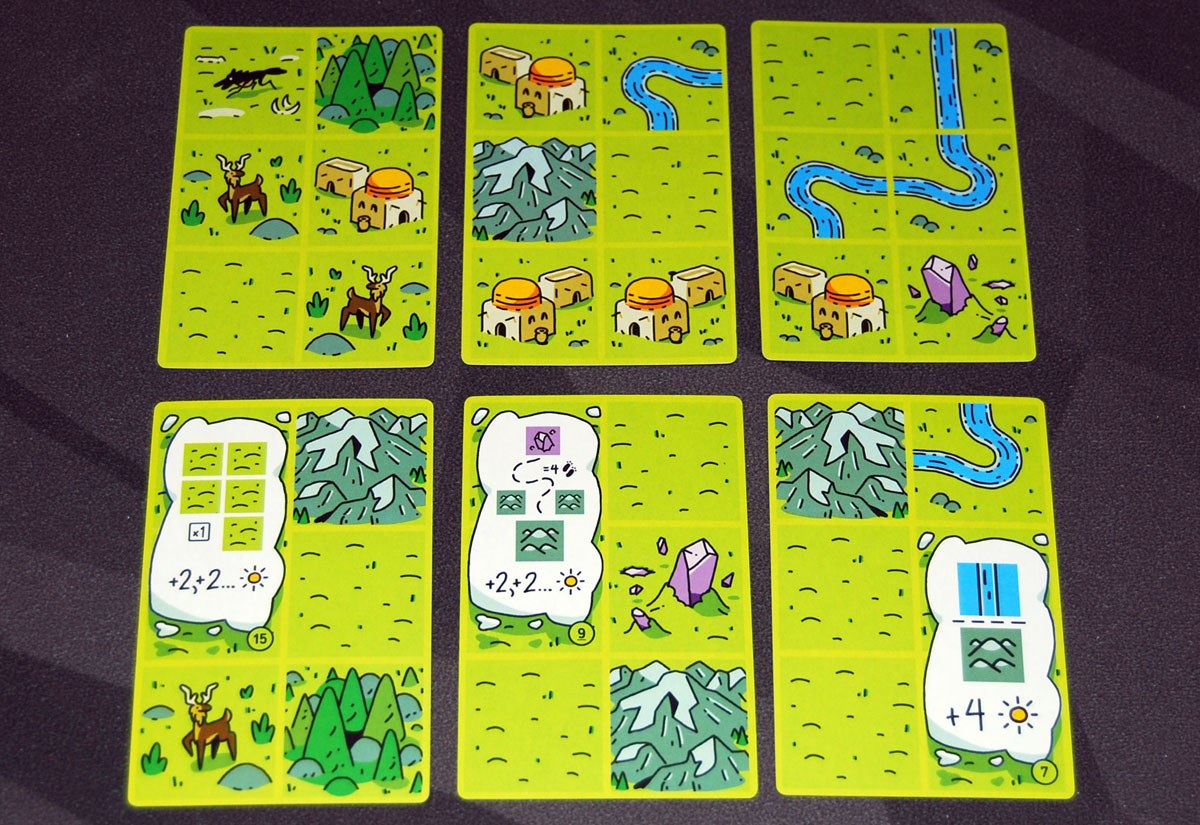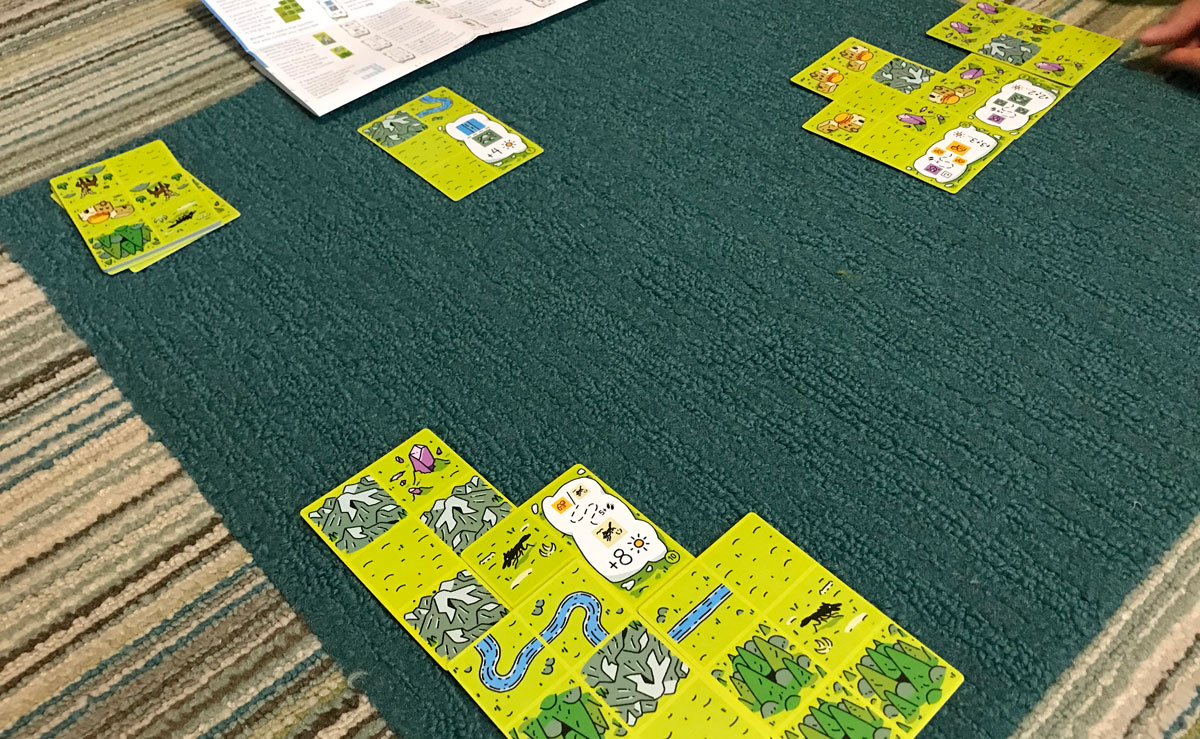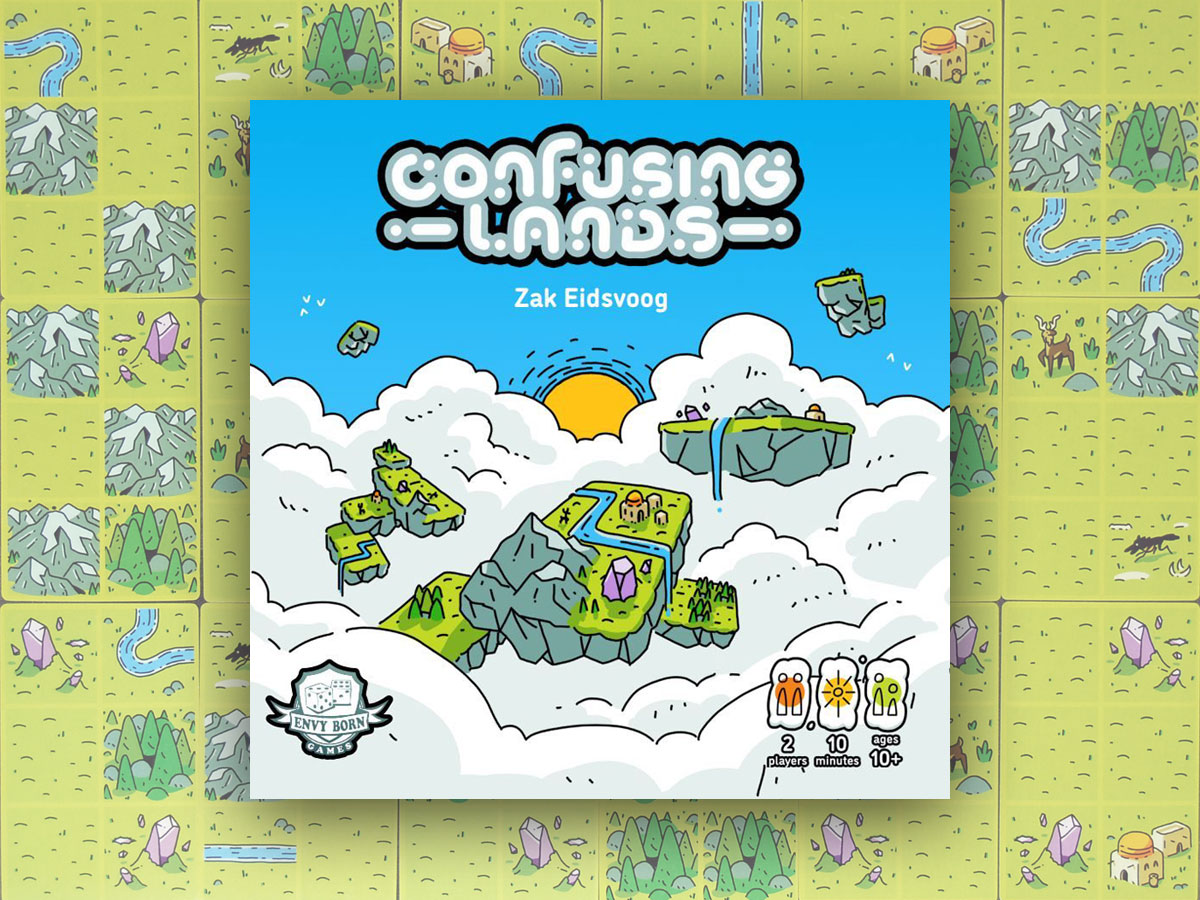Piece together strange floating islands to create the most valuable map!
What Is Confusing Lands?
Confusing Lands is a micro card game for 1 or 2 players, ages 10 and up, and takes about 10 minutes to play. It’s currently available to pre-order from Envy Borne Games for $14.99. The game rules are pretty easy, but the specific scoring conditions can be a little more complex, so your kid’s ability to play it well will depend a bit on their math skills.
Confusing Lands was designed and illustrated by Zak Eidsvoog and published by Envy Born Games.

Confusing Lands Components
Note: My review is based on a prototype copy, so it is subject to change and may not reflect final component quality. While this is very close to being final, there will be some minor changes here and there.
Here’s what comes in the (tiny) box:
- 18 cards
- Score pad
- Pencil
That’s it! The box is a small square box with a lid just about the size of the score pad; while the prototype didn’t include them, the publisher told me the finished box will have the thumb cutouts on the lid to make it easier to open. The scorepad is pretty simple, but because of the number of unique scoring conditions possible per game, I found it was definitely handy to have rather than trying to add up scores in my head.

The cards themselves are standard-sized cards, and each is divided into a 2×3 grid showing various features like mountains, cities, and animals. One side of each card also includes a scoring condition, illustrated in a cloud that takes up two of the squares. The illustrations are simple and clean, with just enough detail to make them interesting without being too cluttered since they’re so small. The scoring conditions are presented with icons—these aren’t all immediately intuitive so you’ll need to refer to the rulesheet until you learn them.
How to Play Confusing Lands
You can download a copy of the rulesheet here.
The Goal
The goal of the game is to score the most points by fulfilling scoring objectives. I’ll explain the 2-player game first, and then the solo game differences.
Setup
Shuffle the deck and place one card face-up in the center of the play area with the scoring condition visible. This condition is shared by both players. Deal two cards to each player and set the rest of the deck nearby, with the scoring conditions face-down.
Gameplay
Both players simultaneously choose one card to play to their own landscape. Each card you play may be placed with either side face-up, and each card you play (after the first) must cover at least one square on an existing card. You may not cover scoring conditions.
After playing the first card, pass the second card to the other player, and then play the card you were passed.
Each player draws two more cards from the deck and repeats.

Game End
The game ends when there aren’t enough cards left to draw (there will be one left in the deck).
Players score points for each of their own scoring conditions, and both players score points for the shared condition. Then, you lose 10 points for each scoring condition in your map (not the shared condition). The higher score wins! In case of a tie, the player with the single highest scoring condition wins.
Solo Game
In the solo game, you draw two cards and play one and discard the other. Then, from the deck, discard the top card and take the next card as the “passed” card. At the end of the game, tally your score and compare it to the chart to rate your map, from “Lost” (below 10 points) to “Astounding” (50 or more points).
Why You Should Play Confusing Lands
Confusing Lands was originally self-published as as print-and-play, and was picked up by Envy Born Games for its Tiny Games series. (You can see a few other Tiny Games titles for pre-order on their website.) I met designer Zak Eidsvoog last year at a local gaming convention when he was running demos of a couple of his games, so it’s cool to see that this title is getting a second round of attention.
At first glance, Confusing Lands seems to share some similarities to a couple of other 18-card microgames I’ve played, like the Sprawlopolis series or Squire for Hire. Both of them involve overlapping cards in particular ways to fulfill scoring objectives, for instance. Sprawlopolis also has scoring conditions on the backs of the cards, but those cards do not have any map portions—you just draw three for the entire game, and play the rest of the cards to fill in the map. Squire for Hire requires you to meet certain requirements in order to earn loot cards to add to your bag, and items can span across multiple squares of the card, so there are some more restrictions about how cards can be played.
The concept of choosing between additional scoring objectives or working toward your existing objectives isn’t totally new: it’s similar to the gamble you can take in Ticket to Ride, drawing more ticket cards or just trying to get train cards to build more routes. Getting more objectives gives you bigger scoring opportunities (in theory), but at the cost of running out of time to complete them.
In Confusing Lands, as in Ticket to Ride, you can be punished for your hubris—but in this case, it’s because every scoring condition you add to your map will cost you 10 points just for having it. To make it worth it, you have to make sure that every condition you keep scores more than 10 points, or else it’s a net loss. But it’s always a gamble—if you don’t add any, then the only thing you’ll score for is the shared condition, which may or may not be lucrative enough. Late in the game, you have to be particularly wary of adding conditions that aren’t already met. And since you’ll only play 8 cards total to your map, the truth is it’s always late in the game.

Some conditions are easy to meet but take a lot of cards to score enough: “Tranquility” gives you a point for every mountain, village, and forest anywhere in your landscape. Some have high values but are harder to get just right: “Forest Spirit” gives you 8 points for every deer that has at least 3 forest spaces around it, so you only need two of them to get positive, but what are the odds you’ll get the right combination of deer and forest? There are others that are easily ruined depending on the cards you’re passed: for instance, at the bottom of the photo above, I placed the “Fierce Hunters” condition, which gives me 8 points for every wolf that’s not too close to other wolves or cities. I thought I was doing well, until I got passed a card that had cities on both sides and the only places I could put it would be too close to a wolf (losing 8 points!) or covered up some of my other scoring conditions. Ouch!
I’ve played Confusing Lands several times both solo and with 2 players. I do think it’s easier with 2 people because you’re competing against another player, and you can make decisions about what to pass based on what the other player is doing, and you only have to compare your score to theirs. With the solo game, the card you get “passed” is completely random, and you can’t rely on what another player is doing to inform your own strategy. After many, many attempts I finally broke the 40-point threshold (bringing me from “Confusing” to “Unbelievable”), but “Astounding” still remains just out of reach! But it’s easy to just reshuffle and start over—I can play a solo game in about 10 minutes or less.
To pre-order Confusing Lands, visit the Envy Born Games website!
Click here to see all our tabletop game reviews.
![]() To subscribe to GeekDad’s tabletop gaming coverage, please copy this link and add it to your RSS reader.
To subscribe to GeekDad’s tabletop gaming coverage, please copy this link and add it to your RSS reader.
Disclosure: GeekDad received a copy of this game for review purposes.





